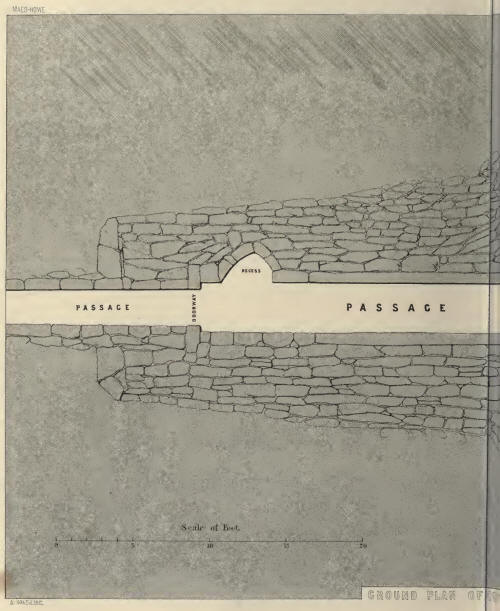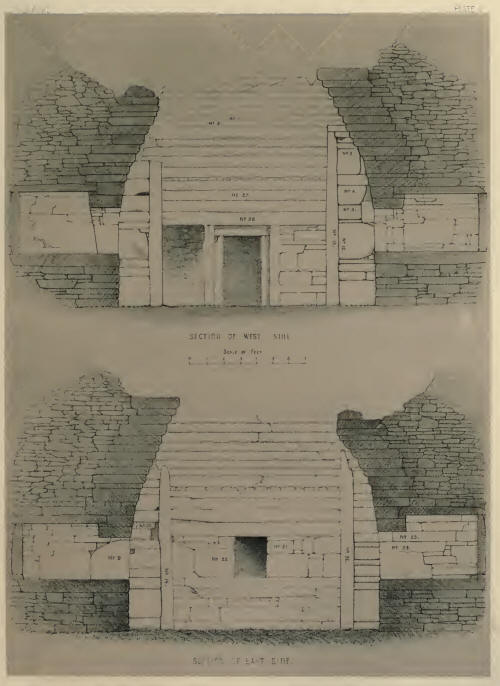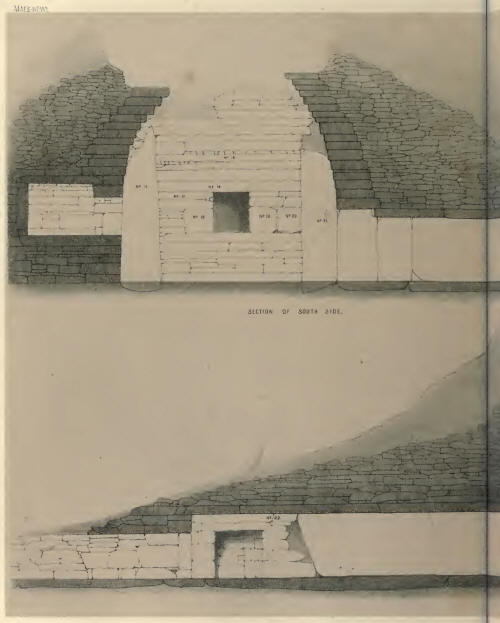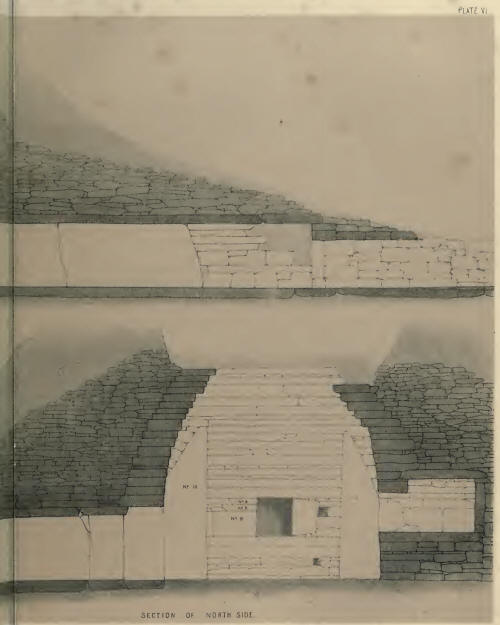|
BARROWS AT
BOOKAN
This barrow is in the
parish of Sandwick, but so near to Stennes that it may have been
regarded as connected with the great circle. It is on the property of
Mr. Watt of Skail, in the West Mainland. It was opened on the 6th of
July, and proved to be a collection of kists or graves. At the north end
of the central kist, a flint lance head, and several fragments of clay
vessels or urns, were found, together with a lump of heavy metal,
supposed to be Manganese, but no bones. In some of the other kists were
human remains in a very decayed state, two jaw bones being the most
perfect. These were much distorted.
Mr. Petrie gives me the
following•measurements:--The Barrow is about 44 feet in diameter, and
about 6 feet high. About 11 feet within the outer margin of the base of
the barrow is a circular wall or facing about 1 foot high. From the
south side of this wall a low passage, 6 feet 3 inches long, 21 inches
in height, and the same in width, leads to a chamber or kist 7 feet long
and 4˝ wide. At the north end of this there was another kist 4 feet 8
inches long, and 3 feet wide. On the east side there was one 4. feet 8
inches long, and 2 feet 9 inches wide ; and on the west side two kists,
both of which were of the same length as that on the east side, and both
were 3 feet in width. They were all about 2 feet 8 inches deep. The
foundation of the surrounding wall or facing was considerably above the
level of the floors of the kists.
LARGE BARROW
CONTAINING GRAVES
The excavation of this
barrow was commenced on the 17th of July 1884. It was found to contain
graves, in one of which was an urn with a quantity of burnt bones and
ashes. It was formed out of a micaceous stone not belonging to Orkney.
It was i foot 9 inches in diameter, about 18 inches deep, and 5 feet 10
inches in circumference, the rim, which projected on the outside all
round, was an inch and a half wide, the kist in which it was deposited
was 2 feet and a half in length, and 2 feet in width, but the side
stones which protected the kist were nearly 6 feet in length, and at the
angles, and on the outside of the kist were quantities of small rolled
pebbles and gravel, probably intended to assist in draining off water.
Clay was placed inside the kist at the different angles; the flags were
about an inch and a half thick, but much decayed; the cover stone was of
an irregular shape, about 4 feet long and 2˝ wide; the urn rested upon
the corners of four flags; it was partly decayed, and could not be
removed till after an interval of two days, when I succeeded in raising
it. It is now in the Museum of the Society of Antiquaries at Edinburgh,
to whom I presented it, with the consent of Mr. Balfour.
In another grave within
the same barrow was found a small urn composed of baked clay and gravel,
nearly filled with soil, and only one or two small pieces of bone. It
was brought to Kirkwall, but could not be preserved, in consequence of
its decayed condition. It was 5 inches in diameter, 17 in circumference,
and 5 deep. The kist was 2 feet 9˝ inches long, and 1 foot 7 inches
wide. The bones, in this instance, had not been placed in the urn, but
were laid on a flagstone in the north-west angle of the kist. It is not
improbable that further investigation might lead to the discovery of
other interments within the same barrow, since neither of those before
described were in the centre of the tumulus, and several instances have
occurred where they have been found near the outside.
MOUNDS AT
STENNES
In the year 1854, I had
partially opened one of the largest of these hillocks, but further
examination last July did not encourage the belief that it was
sepulchral. I was however advised to examine one on the west side of the
Stones of Stennes, and directly opposite to the one previously
mentioned. In both of them the workmen penetrated to a depth of 22 feet,
and over an area of 9 square feet in the one on the west side of the
great circle, but there was no appearance of any kind of building. The
material of which these hillocks are composed is precisely the same as
that which still exists within the circle of stones, and I infer that
when the moat surrounding the circle was excavated, advantage was taken
of the circumstance to raise these hillocks. Fragments of animal, but no
human bones, were found in each, but in both instances near the top.
Building stones are found at the base of both hillocks, but always
embedded in the soil; those which were easy of removal having no doubt
been long since taken away by the country people. Sections were made at
right angles in both of the hillocks, and it was clearly ascertained
that no building of any size could be concealed within.
TENSTONE
In this barrow, which is
in the parish of Sandwick, but adjoining Stennes, I found the remains of
two stone urns. The barrow had been evidently previously opened. There
was reason to believe that these urns had been in separate kists. They
were formed out of a micaceous stone, but the attempt to unite the
fragments was quite hopeless. A few small pieces of human bone were
found. The cover and sidestones of the kists remained in the grave.






|

